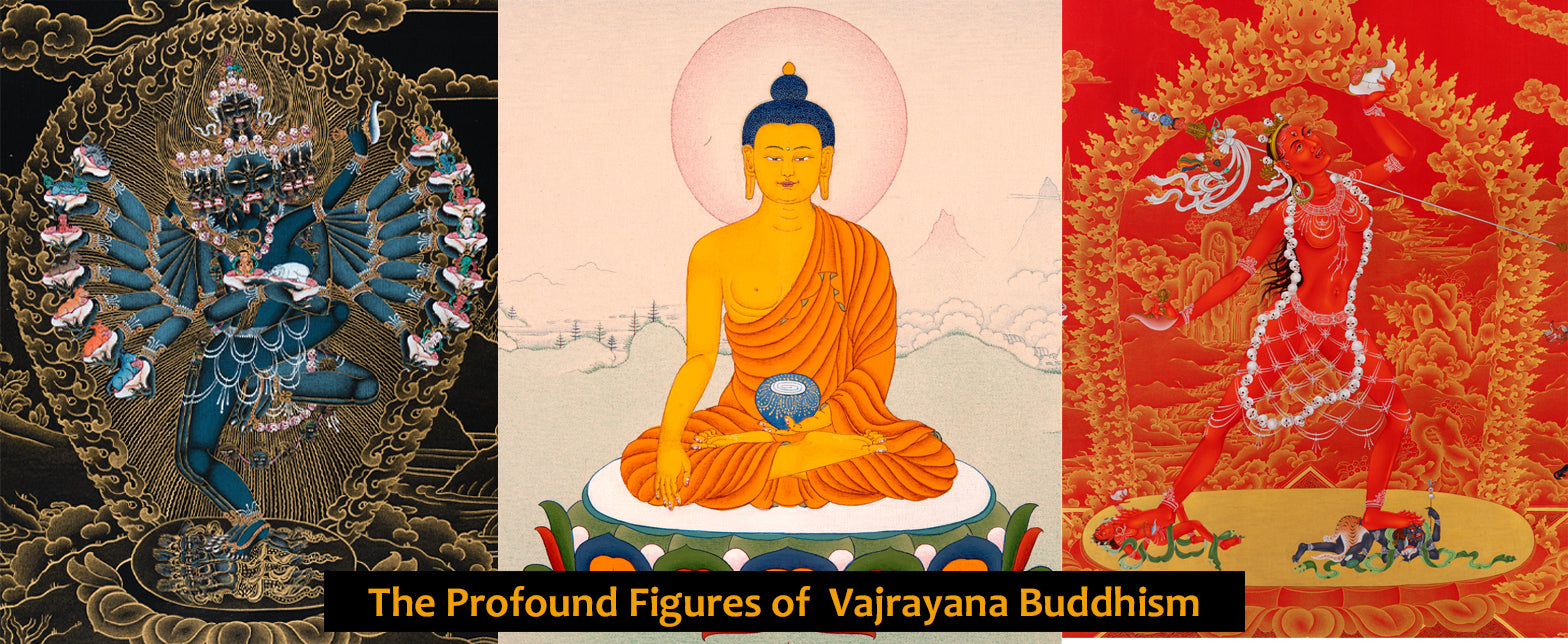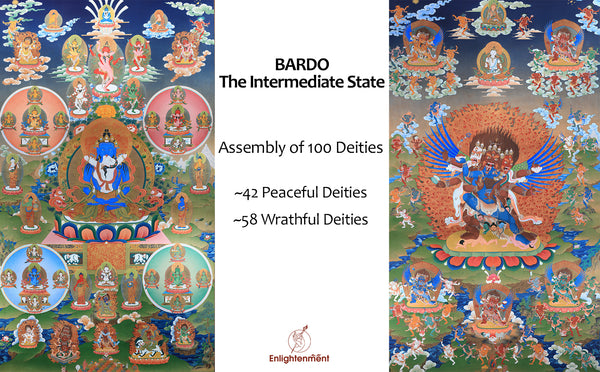Introduction To Vajrayana Buddhism:
Vajrayana Buddhism is an elaborated form of Mahayana which accepts all of its assumption and have some additional form on its own. The main goal of Vajrayana is the attainment of the "Bodhicitta", the mind of enlightenment.
Every sentient beings is a potential Buddha.
But because of lack of awareness and ignorance, we are not able to realize it. There is a dense fog of ignorance that embeds our mind. It is the discursive thoughts that discriminates and polarizes all the concepts. We must get rid of such cloudy thoughts to experience the Bodhicitta, which emerges as a clear light. By combining Prajna (knowledge, wisdom) with Upaya (skillful means), one is able to attain this state of reality.
So, Vajrayana is the belief in the twin principles of insight and compassion and in their co-emergence (Sahaja) which leads on to the state of Mahasukha (the great bliss).
Also, Vajrayana is the shortest path shown to us by Buddha Shakyamuni and by following which we are able to attain Buddhahood in a single life time.
Depictions of Figures in Tibetan Vajrayana Arts:
The Buddhist pantheon of deities include a wide and complexly varied figures, imported mainly from India. All the deities are categorized in to the Five families of Directional Buddhas.
Five Directions Buddha:
These five families have 5 buddha heading an individual family. They are namely: Amitabha, Amoghasiddhi, Vairochana, Akshobya and Ratnasambhava. Each of them are portrayed similar to the Shakyamuni Buddha (with cranial bump, elongated earlobes and an auspicious dot in the forehead called Urna) but with their distinctive emblems.
Learn more about the Five Buddha Family:
All the Buddhist deities are the symbols of either insight or the compassion, through which bodhicitta is developed. For examples:
Tara is the embodiment of Prajna (insight). She protects all the sentient beings from all kinds of natural and supernatural perils. She is the manifestation of the Prajnapramita.
Why some deities have multiple heads, arms and legs?
Firstly, all of the figures of the Vajrayana Buddhism are the symbolic representation of the cosmic principle or consciousness. The complex numbers of arms and legs to their otherwise human form, signifies their universality.
Not essentially, they are multi headed to see all the directions, or they have multiple arms to destroy the demons at once. But because it was a convenient conceptual formula to materialize the pervasiveness of the deity. Such multiplications was an ancient practice, prevalent in both Hindu and Buddhist traditions.
Examples of deities with such complex iconography includes Hevajra, Guhyasamaja, Chakrasamvara, Kalachakra, Prajanaparamita and others.
Wrathful Figures:
The wrathful emanation of deities are non other than a embodiment of insights and a symbol of compassion. Even though they are portrayed as a fierce, gigantic form with wide open mouths, bare fangs, blazing eyebrows, they do not personify the evils.
In fact, these wrathful figures are the representation of the fundamental reality of the Cosmos and its process in the Universe. 
The Protector Deities:
The protector deities are one of the most commonly depicted figures in Tibetan Art.
Tsongkhapa, here describes the concept of protection in Tibetan Buddhism, as he defines the word MANTRA:
"Minds arising dependent on a sense and an object,
are said to be MAN and TRA means protection"
Hence, mantra protects the mind and the basic function of all the Buddhist deity is to protect beings, both internally and externally.
Dharmapala, or the Dharma protectors are the one who guards the Dharma (religion). For example: Mahakala, Palden Lhamo, Yama.
Yidams of Vajrayana:
Yidams are the ones who protects the individual beings.
Example: Vajrayogini, Vajrakilaya, Hevajra.
They are a tutelary deity and helps sentient beings find a way and reach the goal of enlightenment. Hevajra is a Yidam deity of Sakya order while Vajrabhairav is of the Gelug school of Tibetan Buddhism.
One's Yidam is determined by a realized Guru (master) and given to the practitioner during the initiation time.
Who are Dakini?
The female version of Daka (a hero or a wise man), literally mean the "Sky dweller". It simply implies that Dakini can fly freely. She is also regarded as the embodiment of Wisdom, hence frequently appearing the Tibetan Buddhist Texts.
She is also associated with the lives of Mahasiddhas, spiritually guiding them to a path of enlightenment. Or she is also designated as the female consort of the in the tantric practice. 
Arhats:
A common designation in the Tibetan pantheon of deities, Arhats, literally means "Worthy".
It is applied to the venerable ones who have attained Nirvana. Such enlightened ones are singled out by Buddha to preach the beings on the Earth, until the future Buddha Maitreya appears.
Earlier, there were only four Arhats, who represent the four directions. But later on, it was extended to 16 Arhats. It was during the 7th century the concept of 16 Arhats was imported from India to China. Now, it is practiced widely in China and Japan. But rarely it exists in Buddhist countries of Southeast Asia like Srilanka and India.
16 Arhats and Shakyamuni Buddha Thangka:
Mahasiddhas:
The word "Maha" signifies "the greatness" and "Siddha" means a perfected beings.
So, who are Mahasiddha?
They are the perfected beings (Maha) who gained control (Siddhi) over forces of the nature and acquired special abilities. Such abilities were power to fly or cause the storm or rain etc. They are also the ones who have experienced the clear light of enlightenment.
For example Mahasiddha Virupa, stopped the movement of the Sun when he was refused to offer more drinks.
The Tibetan tradition recognize the group of Eight Four Mahasiddha, all from the Indian origin. Most of them were males and appeared from the different stages of their life from royals, brahmins to other professionals. They were the unconventional teachers, mostly wandering Yogis who abandoned all the social norms and lived their lives ascetically.
The Lineage Holders, Buddhist Masters:
The monks and lamalas of different school of Tibetan Buddhism are also one of the commonly portrayed figures in Tibetan Arts. There are four major school of Tibetan Buddhism and various lineage holders and masters. These schools are:
Karmapa, Gelugpa, Nyingma and Sakya pa.
The monks of Gelukpa lineage are distinguished as they wear their peculiar Yellow Hat. Similarly the Lamalas from the Karmapa Tradition wear Black Hat. The lineage holders of the other two schools wear the red colored hats.
Some of these monk carry their individual Yidam Deity as an attribute.
In one account, the venerable Karmapa Dezhin Shegpa said the following, explaining the importance of all the Four School of Tibetan Buddhism:
"One Sect cannot bring order to the lives of all types of people. It is not beneficial to think of converting all sect into one. Each individual Sect is specially constituted so as to accomplish a particular aspect of good activity"




1 comment
Konchok Rangdrol
One of the 4 (or 5 schools if you include the Bon) is the Kagyu (Kagyupa) school. I am sure the letter “K” is what momentarily confused you. The “Karmapa” is a title of the lineage holder of the Kagyu school. Great images and informative text.